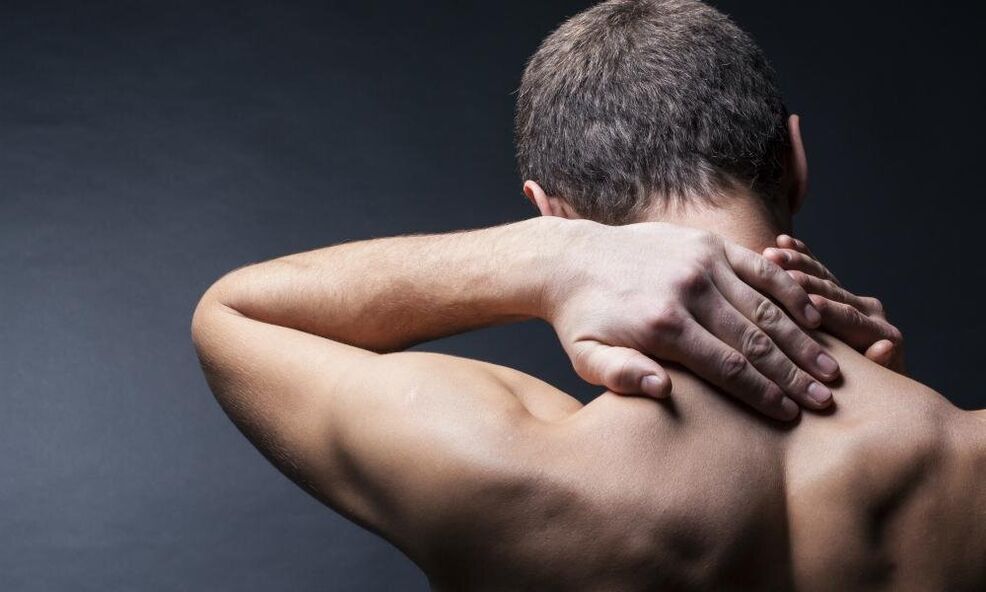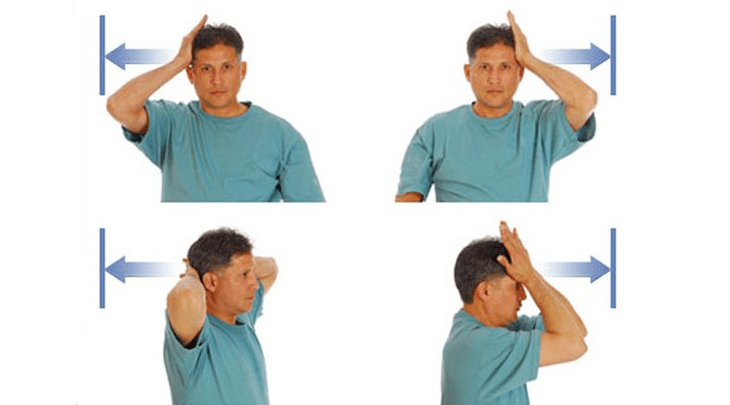Many vital musculoskeletal, nerve and arterial plexuses run through the cervical spine. Different types of neck pain caused by mechanical stress or neurological damage. In addition, the neck can be painful after prolonged static exposure. Let's consider the most likely situations that cause cervical spine pain, determine the symptoms and signs of neurological disorders, and also determine how to use the most effective treatments, including at home, to get rid of pain.

Reasons - why does the neck hurt?
The cervical spine consists of seven vertebrae, of which the seventh is distinguished from other osteoarticular segments of the spine by its greatest mobility. In addition, the fragile intervertebral cervical regions are constantly heavily stressed by the heavy head and thus all the prerequisites for pain in the cervical spine, shoulder girdle and back are created. The anatomical cervical structure includes not only muscles and ligaments, articular cartilage, nerve fibers, and vascular plexuses, but also other life-sustaining organs - the larynx, esophagus, trachea, lymph nodes, and thyroid gland. Each regional inflammation or injury causes different degrees of pain in the neck.
So it can be conditionally classified as to why the cervical spine hurts:
- mechanical injuries to the back and neck;
- systemic diseases of vital organs;
- Defeat by infectious agents;
- degenerative transformations of the spinal region;
- reflective pain symptoms;
- the result of a qualitative change in life or work.
Neurological pathologies that determine the cause and effect relationship of why the back muscles hurt and why the spine hurts in the neck include:
- State of deformation of the intervertebral discs;
- Intervertebral hernia;
- Compression of the spinal nerve;
- Osteochondrosis of the cervical spine.
Systemic etiology why the neck can hurt:
- psoriatic or rheumatoid arthritis;
- Fibromyalgia;
- Neuropathy of a diabetic nature;
- the formation of benign or malignant tumors.
If the neck is very painful due to an infectious lesion, the following clinic is determined:
- Meningitis;
- an acute or chronic form of thyroiditis explains why the anterior neck hurts;
- Tuberculosis;
- it hurts to swallow, and sometimes a sore throat and ear with inflammation of the cervical lymph nodes - lymphadenitis.
Other etiological factors are:
- passive lifestyle;
- excessive overloading of muscle regions;
- nervous exhaustion;
- improper arrangement of a sleeping place if the neck hurts even after an orthopedic pillow.
In addition, the neck hurts constantly after seemingly insignificant cervical bruises, for example after an accident in an accident, after a fall or collision.
The causes of neck pain can occur with alcohol syndrome. After drinking copious amounts of alcohol, acute cervical vertebral pain also occurs, which often radiates into the ear, head (at the base of the skull and at the temples).
Symptoms
If the neck hurts due to osteochondrosis or its complicating neurological pathology (intervertebral hernia), the symptoms of pain are expressed as follows:
- the pain begins to be aching or pulling on the sides to the cervical vertebrae;
- The back and neck are very painful, especially in the area of the collarbone;
- tilting and / or turning the head causes acute or sharp pain in the neck regions;
- Have difficulty swallowing;
- there is a strong stiffness of the movements;
- if there is pain there are general signs of cervicalgia.
With an infectious lesion of the cervical spine segments, symptoms are expressed by the following symptoms:
- there is a local temperature increase with a cold throat, a temperature of 37 ° and more;
- sometimes there is abdominal pain due to metabolic disorders;
- metabolic processes affect the work of the gastrointestinal tract (the stomach can get sick, sometimes nausea and vomiting appear);
- Neck damage can be expressed by tonic muscle syndrome;
- there is an increased irritability and rapid fatigue of the body.
Painful symptoms are common in teenagers or toddlers, such as cervical lymphadenitis or parotitis, when the parotid glands become inflamed. A small patient begins to have pain behind the ear, difficulty swallowing and radiating pain from the base of the skull, while the neck hurts not only from the side, but also along the entire periphery. Parents should pay attention to the clarity of the contours of the neck, which change noticeably, they swell and when palpating a slight thickening of the skin can be felt. It is not difficult to draw a conclusion.
The listed symptoms of possible complications caused by painful cervical attacks look too frightening to an uninformed person. You should therefore not do a self-diagnosis, but consult a doctor immediately. Often times, these pain symptoms are most active in women during pregnancy. Only a qualified specialist will decide what to do with neck pain and how to treat this or that clinical pathology.
What to do?
Excluding all possible clinical pathologies of neck pain, we will consider the methods of treatment of the most common neurological problem - osteochondrosis of the cervical spine.
The classic medical definition of a neuralgic condition is a degenerative-dystrophic lesion of the articular cartilage of the cervically movable segment of the spine. It is possible to correct the situation at home with drugs, methods of physiotherapy, special exercises, massages and treatments with folk remedies. With a severe exacerbation, anti-inflammatory and analgesic pharmacological treatments are used.
After completing the mandatory treatment with drugs, complex rehabilitation therapy can be continued at home.
Neck exercises
The main rule when performing physical therapy exercises for the cervical spine is leisurely, slow and gentle movements. The medical and rehabilitation complex consists of the following simple physical exercises:
- You should start by tilting your head back and forth, with a gradual increase in amplitude. Enough for the first session 3-5 times.
- The next exercise is circular motions and neck rotations to the right and left.
- The next exercise will take some effort. An exercise stick is placed under the chin and should be pressed as hard as possible. The exercise is performed 2-3 times.
Attention!In the event that the pain in the neck radiates into the arm, shoulder girdle or collarbone, the exercise should be stopped and the attending physician should be consulted.
Massage treatments are also an effective way to relieve pain in the cervical area. The aim of the therapeutic and prophylactic measure is to restore blood circulation and alleviate muscle spasms. The massage therapist should begin the treatment with light strokes along the neck. However, you shouldn't get too carried away with your own neck during training and rub it intensely, as sometimes the neck hurts after the massage, which is not always a quality feature.

Pain relief according to the method of the academic
There is a special author's method of managing pain in cervical osteochondrosis that was developed by an academic. A conventional pencil is used as a functional solution, which acts on the so-called cervical spine, shown in the area of the thumb. This area is located between the palmar fold and the upper joint fold of the thumb. The author calls the distance between these segments the cervical space. The pain is relieved by intense rubbing with a pencil until a stable heat, the projection of the cervical spine, appears. Such treatment and prophylaxis can be carried out in almost any condition, including outside the home. Some medical professionals disapprove of the effectiveness of this method, but many patients using this development believe that such a procedure brings some relief.
What to do at home
To relieve muscle tension, ensure healthy blood flow in the cervical canals, facilitate the work of the joint elements of the spine, allow the following homemade recipes:
- Salt baths with magnesium sulfate are an effective relaxation measure for cramped neck areas.
- A brew made from pine buds. For 100 grams of forest product, 200 ml of water are consumed. The entire composition is brought to a boil and kept in a dark place for another 4-5 hours. The remedy is used as a cervical compress.
- Decoctions made from dill seeds and / or parsley root are very helpful. Making homemade medicine is easy enough. For 50 grams of any of the herbal products, you need to take a glass of boiling water. The healing broth is infused for 1–1. 5 hours and then used for internal or external use.
- Rubbing alcohol based on iodine and camphor oil. 10 drops of iodine and the same amount of camphor oil are taken per 200 ml of 96% alcohol. The medicine is mixed and used as a compress for the throat.
- An equally effective method of relieving pain is a mixture of 150 ml of vodka and 100 ml of natural honey.
- You can make a homemade healing recipe from grated potatoes and honey. Hot potatoes, cooked in "uniform", are ground with the addition of a tablespoon of honey. This lozenge should be applied to the inflamed area of the throat.
It is important to know,that compresses only have a therapeutic effect after 30-40 minutes.
The given examples of traditional medicine are only suitable in the initial stage of osteochondrosis. If the symptoms worsen, for example a herniated disc, the prescription suggestions should be coordinated with the attending physician. In addition, if you are allergic to certain treatment products, these should not be used.

Prevention of pain
There is no single therapeutic and prophylactic effect for all types of cervical spine pain. It is possible to protect your body from various causal factors of the appearance of symptomatic manifestations, possibly only if a healthy lifestyle (without alcohol, smoking, etc. ) is observed and an annual preventive examination is carried out by a therapist or specialized specialist.

















































